第二外语的学习方法
国际视野下基于“柏林教学论模式的德语作为第二外语教学研究
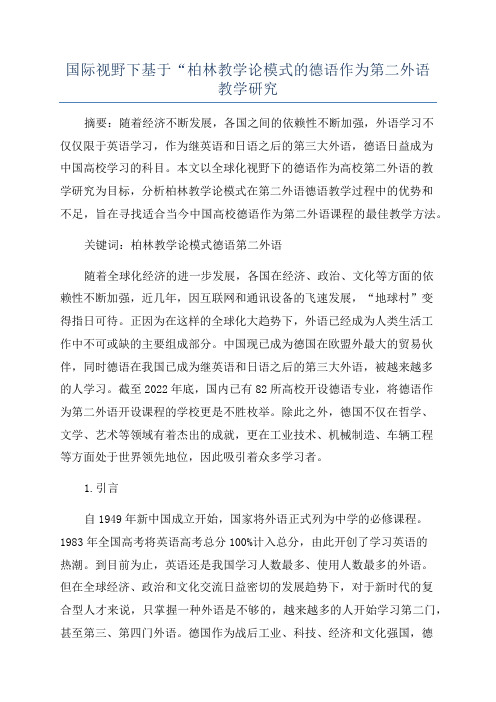
国际视野下基于“柏林教学论模式的德语作为第二外语教学研究摘要:随着经济不断发展,各国之间的依赖性不断加强,外语学习不仅仅限于英语学习,作为继英语和日语之后的第三大外语,德语日益成为中国高校学习的科目。
本文以全球化视野下的德语作为高校第二外语的教学研究为目标,分析柏林教学论模式在第二外语德语教学过程中的优势和不足,旨在寻找适合当今中国高校德语作为第二外语课程的最佳教学方法。
关键词:柏林教学论模式德语第二外语随着全球化经济的进一步发展,各国在经济、政治、文化等方面的依赖性不断加强,近几年,因互联网和通讯设备的飞速发展,“地球村”变得指日可待。
正因为在这样的全球化大趋势下,外语已经成为人类生活工作中不可或缺的主要组成部分。
中国现已成为德国在欧盟外最大的贸易伙伴,同时德语在我国已成为继英语和日语之后的第三大外语,被越来越多的人学习。
截至2022年底,国内已有82所高校开设德语专业,将德语作为第二外语开设课程的学校更是不胜枚举。
除此之外,德国不仅在哲学、文学、艺术等领域有着杰出的成就,更在工业技术、机械制造、车辆工程等方面处于世界领先地位,因此吸引着众多学习者。
1.引言自1949年新中国成立开始,国家将外语正式列为中学的必修课程。
1983年全国高考将英语高考总分100%计入总分,由此开创了学习英语的热潮。
到目前为止,英语还是我国学习人数最多、使用人数最多的外语。
但在全球经济、政治和文化交流日益密切的发展趋势下,对于新时代的复合型人才来说,只掌握一种外语是不够的,越来越多的人开始学习第二门,甚至第三、第四门外语。
德国作为战后工业、科技、经济和文化强国,德语自然成为较佳选择,成为在中国继英语和日语之后的第三大外语。
“中国赴德留学人数已排在非英语国家的首位”①。
王银泉在他的《从国家战略高度审视我国外语教育的若干问题》②中提出,“我国的外语教育战略不但缺少科学规划,而且没有紧跟时代发展的步伐培养创新思维和创新能力”。
学习第二外语是有用的作文中文
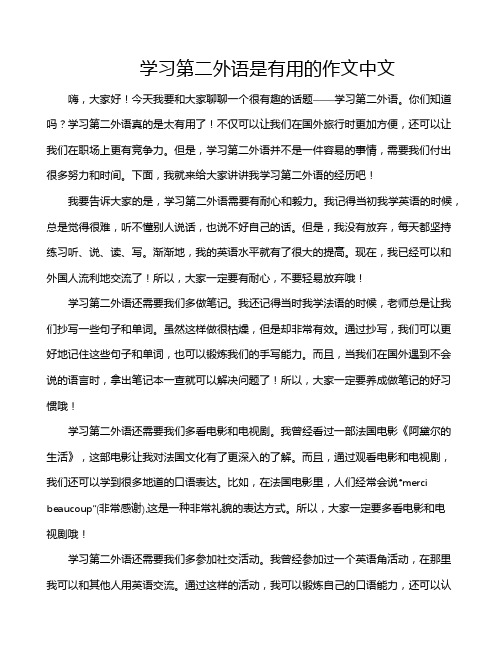
学习第二外语是有用的作文中文嗨,大家好!今天我要和大家聊聊一个很有趣的话题——学习第二外语。
你们知道吗?学习第二外语真的是太有用了!不仅可以让我们在国外旅行时更加方便,还可以让我们在职场上更有竞争力。
但是,学习第二外语并不是一件容易的事情,需要我们付出很多努力和时间。
下面,我就来给大家讲讲我学习第二外语的经历吧!我要告诉大家的是,学习第二外语需要有耐心和毅力。
我记得当初我学英语的时候,总是觉得很难,听不懂别人说话,也说不好自己的话。
但是,我没有放弃,每天都坚持练习听、说、读、写。
渐渐地,我的英语水平就有了很大的提高。
现在,我已经可以和外国人流利地交流了!所以,大家一定要有耐心,不要轻易放弃哦!学习第二外语还需要我们多做笔记。
我还记得当时我学法语的时候,老师总是让我们抄写一些句子和单词。
虽然这样做很枯燥,但是却非常有效。
通过抄写,我们可以更好地记住这些句子和单词,也可以锻炼我们的手写能力。
而且,当我们在国外遇到不会说的语言时,拿出笔记本一查就可以解决问题了!所以,大家一定要养成做笔记的好习惯哦!学习第二外语还需要我们多看电影和电视剧。
我曾经看过一部法国电影《阿黛尔的生活》,这部电影让我对法国文化有了更深入的了解。
而且,通过观看电影和电视剧,我们还可以学到很多地道的口语表达。
比如,在法国电影里,人们经常会说“merci beaucoup”(非常感谢),这是一种非常礼貌的表达方式。
所以,大家一定要多看电影和电视剧哦!学习第二外语还需要我们多参加社交活动。
我曾经参加过一个英语角活动,在那里我可以和其他人用英语交流。
通过这样的活动,我可以锻炼自己的口语能力,还可以认识很多新朋友。
而且,当我们在国外旅游或者工作时,我们还可以借此机会结识更多的人,扩大自己的社交圈子。
所以,大家一定要多参加社交活动哦!学习第二外语是一件非常有意义的事情。
它不仅可以让我们在国外旅行时更加方便,还可以让我们在职场上更有竞争力。
但是,学习第二外语并不是一件容易的事情,需要我们付出很多努力和时间。
学习策略在第二语言学习中的效用

学 习 策 略 在 第 二 一 语 l , 口言 仁 — 学 , 一— 习 r J 中 的 效 用
为可能。
关键词 : 学 习策 略
一
元认知策略
第二语言学 习
学习策略的效用 在 非 母 语 的语 言学 习 和 教 学 过 程 中 , 当接 触 了 教 师 输 人 的材 料 之 后 , 学生的大脑首先会引起一定 的注意 , 此 时 内 因 和 外 因都 会 对 这 一 注 意过 程 产 生 一 定 的 影 响 。短 时 记 忆 和 长 期 记 忆 两 者 之 间 的分 析 过 程 是 互 动 的 ,短 时 记 忆 对 这 些 信 息 进 行 了一系列加工: 信息 匹配 、 信息 类推 、 信息重组 、 信 息 转 换 和 信 息 的理 解 , 这些过程会对第二语言加以了解和掌握。 学 生 对 输 入 的语 言 进 行 内 部 处 理 ,与 此 同 时 产 生 一 种 中 介 语 ( i n t e r - l a n g u a g e ) , 经 过 中介 语 形 成 的第 二 语 言 的顺 利 表 达 , 这 个 过 程 就是输出。 学生在从输入到输出的过程中 , 大 脑 活 动 涉 及 以下 过程: 注意过 程 、 记 忆过程 、 思 维过程 、 信 息处理 过程 、 母 语 转 移过 程 , 以及 中 介 语 的 形 成 过 程 。 第 二语 言的认 知 策略 , 是 指在 处理 外语 的信 息过 程 中 , 学 生 自己 运 用 的 一 定 的手 段 和 方 法 。 学 生 在 外 语 的 学 习 过 程 巾是处于 主体地 位 的 . 在 进行语 言输 入 时 . 会 对 语 言 进 行 定 的处理 和分 析: 在 完成 这个 学习 和认 知 的过 程之后 。 会 自觉 、 不 自觉 地 调 动 自 己 已 经 掌 握 的 知 识 策 略 和 认 知 策 略 , 对 语 言材 料 进 行 自我 加 工 , 随 后 再 次 进 入 理解 和 记 忆 。 因此 , 英语 教 师必 须充 分考 虑 学生 的 主观 能动 性 。 同 时 教 师 要 充 分利 用学生 的认 知能力这 一优 势 , 因材 施 教 , 加 强 策 略 教 学 的训练 , 这 样 才 能 提 高 学 生 的 分 析 问 题 的 能力 和 解 决 问 题 的 能力 。 二、 元 认 知 策 略 在 外 语 学 习 中的 效 用 元认知策略可以分为三类 : 1 . 计划策略: 计 划 策 略 包 括 设 置 学 习 目标 、 浏 览 阅 读 过 的 材料 、 产 生 需 要 回答 的 问题 和 分 析 怎 样 完 成 学 习 任 务 。 为 自己 做 好 学 习 计 划 是 学 习过 程 中 的一 个 重 要 环 节 。成 功 的学 生 不 只是会听课 、 做 笔 记 和 等 待 老 师 布 置 测 验 的 内容 。 还 会 预 测 完 成作业需要的时间有多长 . 在完成前获取相关 的信息 . 在 考 试 前整理需要的笔记 。 2 . 监 控 策略 : 监 控 策 略 包 括 做 阅 读 时 要 对 注 意 加 以跟 踪 . 要 对 材 料 进 行 一 定 的 自我 提 问 .要 在 考 试 过 程 中对 自己 的速 度和时间进行一定的监测。 3 . 调节策略: 调 节 策 略可 以 帮 助 学 生 纠 正 学 习 中 的 主要 弊 端, 使 学 生 能够 弥补 理解 上 的 大 量 不 足 。举 个 例 子 , 当学 生 明 白 自 己不 能 理 解 课 文 某 一 部 分 内 容 时 , 就 会 自动 地倒 退 回去 . 再 次 阅 读 那 部 分 不 理 解 的段 落 . 在 阅读 时 。 学 生 会 使 用 放 慢 速 度等策略 。
你的第二外语选什么----欧洲各大语言难易度比较
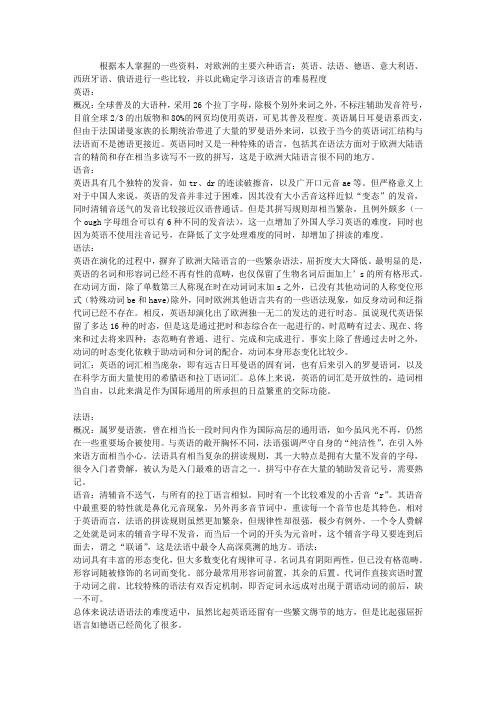
根据本人掌握的一些资料,对欧洲的主要六种语言:英语、法语、德语、意大利语、西班牙语、俄语进行一些比较,并以此确定学习该语言的难易程度英语:概况:全球普及的大语种,采用26个拉丁字母,除极个别外来词之外,不标注辅助发音符号,目前全球2/3的出版物和80%的网页均使用英语,可见其普及程度。
英语属日耳曼语系西支,但由于法国诺曼家族的长期统治带进了大量的罗曼语外来词,以致于当今的英语词汇结构与法语而不是德语更接近。
英语同时又是一种特殊的语言,包括其在语法方面对于欧洲大陆语言的精简和存在相当多读写不一致的拼写,这是于欧洲大陆语言很不同的地方。
语音:英语具有几个独特的发音,如tr、dr的连读破擦音,以及广开口元音ae等。
但严格意义上对于中国人来说,英语的发音并非过于困难,因其没有大小舌音这样近似“变态”的发音,同时清辅音送气的发音比较接近汉语普通话。
但是其拼写规则却相当繁杂,且例外颇多(一个ough字母组合可以有6种不同的发音法),这一点增加了外国人学习英语的难度,同时也因为英语不使用注音记号,在降低了文字处理难度的同时,却增加了拼读的难度。
语法:英语在演化的过程中,摒弃了欧洲大陆语言的一些繁杂语法,屈折度大大降低。
最明显的是,英语的名词和形容词已经不再有性的范畴,也仅保留了生物名词后面加上’s的所有格形式。
在动词方面,除了单数第三人称现在时在动词词末加s之外,已没有其他动词的人称变位形式(特殊动词be和have)除外,同时欧洲其他语言共有的一些语法现象,如反身动词和泛指代词已经不存在。
相反,英语却演化出了欧洲独一无二的发达的进行时态。
虽说现代英语保留了多达16种的时态,但是这是通过把时和态综合在一起进行的,时范畴有过去、现在、将来和过去将来四种;态范畴有普通、进行、完成和完成进行。
事实上除了普通过去时之外,动词的时态变化依赖于助动词和分词的配合,动词本身形态变化比较少。
词汇:英语的词汇相当庞杂,即有远古日耳曼语的固有词,也有后来引入的罗曼语词,以及在科学方面大量使用的希腊语和拉丁语词汇。
二外:欧洲各大语言难易度比较

根据本人掌握的一些资料,对欧洲的主要六种语言:英语、法语、德语、意大利语、西班牙语、俄语进行一些比较,并以此确定学习该语言的难易程度英语:概况:全球普及的大语种,采用26个拉丁字母,除极个别外来词之外,不标注辅助发音符号,目前全球2/3的出版物和80%的网页均使用英语,可见其普及程度。
英语属日耳曼语系西支,但由于法国诺曼家族的长期统治带进了大量的罗曼语外来词,以致于当今的英语词汇结构与法语而不是德语更接近。
英语同时又是一种特殊的语言,包括其在语法方面对于欧洲大陆语言的精简和存在相当多读写不一致的拼写,这是于欧洲大陆语言很不同的地方。
语音:英语具有几个独特的发音,如tr、dr的连读破擦音,以及广开口元音ae等。
但严格意义上对于中国人来说,英语的发音并非过于困难,因其没有大小舌音这样近似“变态”的发音,同时清辅音送气的发音比较接近汉语普通话。
但是其拼写规则却相当繁杂,且例外颇多(一个ough字母组合可以有6种不同的发音法),这一点增加了外国人学习英语的难度,同时也因为英语不使用注音记号,在降低了文字处理难度的同时,却增加了拼读的难度。
语法:英语在演化的过程中,摒弃了欧洲大陆语言的一些繁杂语法,屈折度大大降低。
最明显的是,英语的名词和形容词已经不再有性的范畴,也仅保留了生物名词后面加上’s的所有格形式。
在动词方面,除了单数第三人称现在时在动词词末加s之外,已没有其他动词的人称变位形式(特殊动词be和have)除外,同时欧洲其他语言共有的一些语法现象,如反身动词和泛指代词已经不存在。
相反,英语却演化出了欧洲独一无二的发达的进行时态。
虽说现代英语保留了多达16种的时态,但是这是通过把时和态综合在一起进行的,时范畴有过去、现在、将来和过去将来四种;态范畴有普通、进行、完成和完成进行。
事实上除了普通过去时之外,动词的时态变化依赖于助动词和分词的配合,动词本身形态变化比较少。
词汇:英语的词汇相当庞杂,即有远古日耳曼语的固有词,也有后来引入的罗曼语词,以及在科学方面大量使用的希腊语和拉丁语词汇。
其它语言学习-第二外语学什么好
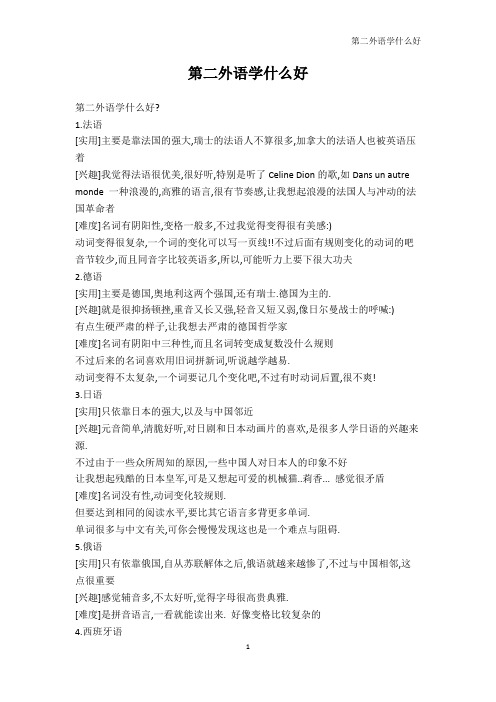
第二外语学什么好第二外语学什么好?1.法语[实用]主要是靠法国的强大,瑞士的法语人不算很多,加拿大的法语人也被英语压着[兴趣]我觉得法语很优美,很好听,特别是听了Celine Dion的歌,如Dans un autre monde 一种浪漫的,高雅的语言,很有节奏感,让我想起浪漫的法国人与冲动的法国革命者[难度]名词有阴阳性,变格一般多,不过我觉得变得很有美感:)动词变得很复杂,一个词的变化可以写一页线!!不过后面有规则变化的动词的吧音节较少,而且同音字比较英语多,所以,可能听力上要下很大功夫2.德语[实用]主要是德国,奥地利这两个强国,还有瑞士.德国为主的.[兴趣]就是很抑扬顿挫,重音又长又强,轻音又短又弱,像日尔曼战士的呼喊:)有点生硬严肃的样子,让我想去严肃的德国哲学家[难度]名词有阴阳中三种性,而且名词转变成复数没什么规则不过后来的名词喜欢用旧词拼新词,听说越学越易.动词变得不太复杂,一个词要记几个变化吧,不过有时动词后置,很不爽!3.日语[实用]只依靠日本的强大,以及与中国邻近[兴趣]元音简单,清脆好听,对日剧和日本动画片的喜欢,是很多人学日语的兴趣来源.不过由于一些众所周知的原因,一些中国人对日本人的印象不好让我想起残酷的日本皇军,可是又想起可爱的机械猫..莉香... 感觉很矛盾[难度]名词没有性,动词变化较规则.但要达到相同的阅读水平,要比其它语言多背更多单词.单词很多与中文有关,可你会慢慢发现这也是一个难点与阻碍.5.俄语[实用]只有依靠俄国,自从苏联解体之后,俄语就越来越惨了,不过与中国相邻,这点很重要[兴趣]感觉辅音多,不太好听,觉得字母很高贵典雅.[难度]是拼音语言,一看就能读出来. 好像变格比较复杂的4.西班牙语[实用]没有较强的国家,只是依靠使用国家多(西班牙,除巴西外的拉丁美洲)[兴趣]元音简单,与日语一样很清脆,还有大舌颤单,唱起歌来很好听.让我想起热情的西班牙舞蹈,拉美足球[难度]是拼音语言,一看就能读.只有阴阳性,动词我还没太多研究,估计动词会易于法语,难于德语其实,只要选择一定实用性的,最有兴趣的二外就行了.论实用性,小语种都不如英语,有时实用性与你所从事行业与将来要合作的外国公司有关。
日语语言的特点及学习方法——针对师范类英语专业学生怎样学习第二外语

这个 句 型就 是从 双 重 否定 表示 肯 定 中译过 来 的 .实际 上 它本 身 的意 思 是 “ 不做 这个 动 作 不行 ” 。这个 典 型 的句 子 充分 体现 了 日
本人 喜 欢用 否定 的特 点 。 从 上 述示 例 中不 难总 结 出 . 句 型 要在 理 解 的基 础上 去 记忆 才 行 ,任何 死 记硬 背 的方 式 到 最后 都 不 能使 句 型被 灵 活 的掌握 和 正确 的 运用 。
新组 合 就 是 “ 先生 ” 这个 新词 , 而 且和 在 原 来词 中的 读 音 是 相 同 的 。这样 记 起 单词 来 就方 便 了许 多 , 不 用 逐 一 的死记 硬 背 , 不但 复 习 了前 面的 单词 , 而 且这 个 新词 也 很容 易 就记 住 了 。 再 有 就是
以上 是一 些 日语 语言 的 基本 特 点 , 那 么作 为一 种语 言 , 它 必
率非 常 高 的字根 , 然 后 把他 们 拆开 重新 排列 组 合 。 就 变成 了许 多
新 的单词 。再 比如 , 学习“ 先生 ” 这 个词 时 , 可 以通 过 前面 学 过 的
“ 先迥” 和“ 学生” 这 两个 词 , 把其 中的 “ 先” 和“ 生” 单 独 拿 出来 重
语 法 书 中都 是通 过各 种 句 型来 展现 出来 的 。 同时 任 何语 言 中句 子 的语 法都 是复 杂 多变 的 , 这就 给 我们 的 学 习带来 一 定 的难 度 。
我们 要 知 道 句 型 只是 总 结 出来 便 于 我们 学 习句 子 的 一种 形 式 , 我们 把 总结 出 的句 型再 重新 拆 开进 行分 析 ,通过 直 译 的方 式 翻 译一下, 在理 解 的基 础上 记 忆起 来 就容 易 的 多 了。 例如 “ — —
论学习第二外语
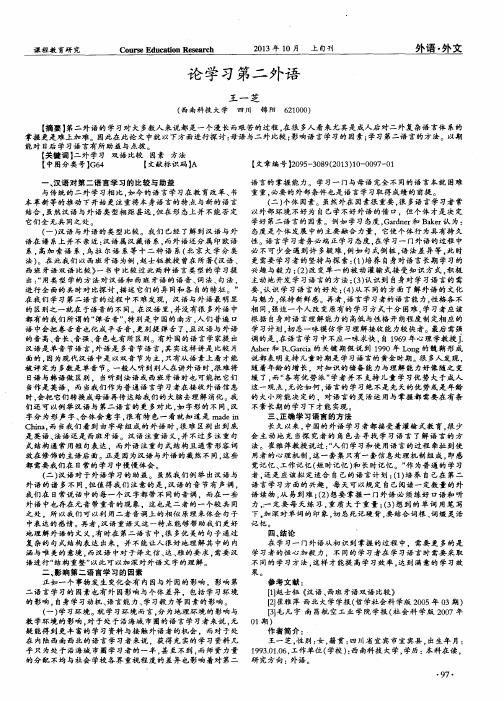
们 还 可 以例 举 汉语 与 第 二 语 言 的 更 多 对 比 ,如 字 形 的 不 同 ,汉 不 紊 长 期 的 学 习下 才 能 实 现 。
汉 语 是 单 音 节 语 言 。外语 是 多 音 节 语 言 ,其 实 这 样 讲 是 比较 片 Asher和 1L.Garcia的 关 键 期 假 说 到 1990年 Long的 髓 鞘 形 成
面 的 。因为 现 代 汉语 中是 以 双 音 节 为 主 ,只 有从 语 素 上 看 才 能 说 都 表 明 支持 儿 童 时 期 是 学 习语 言 的黄 金 时期 。很 多人 发 现 。
语 中会 把 卷 舌 音 也 化 成 平 舌 音 。更 别提 弹 舌 了 。且 汉 语 与 外 语 学 习计 划 .切 忌一 味 模 仿 学 习理 解 接 收 能 力较 快 者 。最后 需强
的 音 高 、音 长 、音 强 、音 色也 有 所 区别 。有 外 国 的语 言 学 家提 出 调 的 是 ,在 语 言 学 习 中不 应 一 味 求 快 ,自 1969年 心理 学教 授 T.
能对 日后 学 习语 言有 所 助 益 与点 拨 。
【关键词 】二外学习 双语 比较 因素 方法
【中图分类号】G64
【文献标识码 】A
【文章编号 】2095—3089(2013)10—0097—01
一 、 汉 语 对 第 二语 言 学 习的 比较 与 助 益
语 言 的 掌 握 能 力 。 学 习一 门与 母 语 完全 不 同 的语 言 本 就 困难
结 合 ,虽 然 汉 语 与 外 语 类 型 相 距 甚 远 ,但 在 形 态上 并 不 能 否 定 以 外 部 环 境 不 好 为 自己 学 不好 外语 的借 口 .但 个 体 才 是 决 定
第二语言习得中外语思维的培养
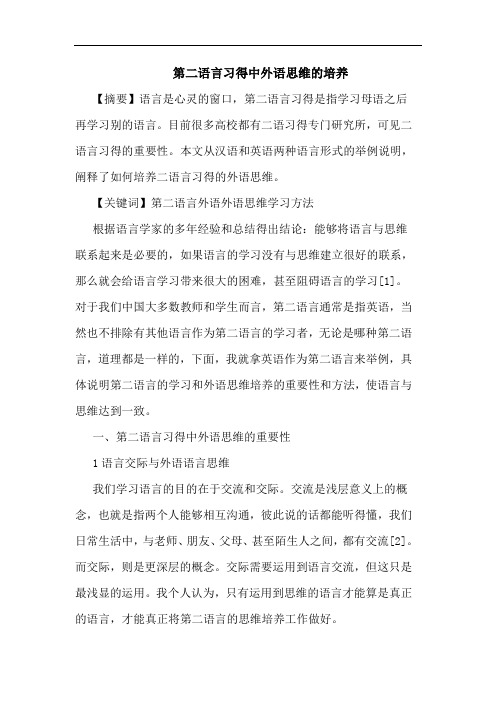
第二语言习得中外语思维的培养【摘要】语言是心灵的窗口,第二语言习得是指学习母语之后再学习别的语言。
目前很多高校都有二语习得专门研究所,可见二语言习得的重要性。
本文从汉语和英语两种语言形式的举例说明,阐释了如何培养二语言习得的外语思维。
【关键词】第二语言外语外语思维学习方法根据语言学家的多年经验和总结得出结论:能够将语言与思维联系起来是必要的,如果语言的学习没有与思维建立很好的联系,那么就会给语言学习带来很大的困难,甚至阻碍语言的学习[1]。
对于我们中国大多数教师和学生而言,第二语言通常是指英语,当然也不排除有其他语言作为第二语言的学习者,无论是哪种第二语言,道理都是一样的,下面,我就拿英语作为第二语言来举例,具体说明第二语言的学习和外语思维培养的重要性和方法,使语言与思维达到一致。
一、第二语言习得中外语思维的重要性1语言交际与外语语言思维我们学习语言的目的在于交流和交际。
交流是浅层意义上的概念,也就是指两个人能够相互沟通,彼此说的话都能听得懂,我们日常生活中,与老师、朋友、父母、甚至陌生人之间,都有交流[2]。
而交际,则是更深层的概念。
交际需要运用到语言交流,但这只是最浅显的运用。
我个人认为,只有运用到思维的语言才能算是真正的语言,才能真正将第二语言的思维培养工作做好。
在二语言习得中,常常造成语言思维的不同步。
因为语言信息是物质抽象的,我们在大脑系统里输入的是感知与理解,输出的才是发音[3]。
思维是语言的物质外壳,语言是表象,思维才是本质。
很多科学家研究后觉得思维与语言在一定程度上是可分的,但是这不够科学。
想要真正学好一门语言,就必须达到思维和语言的统一。
2.从母语向第二外语语言思维的过渡第二语言习得的最大难处就是将思维从母语过渡到第二语言(通常是英语)。
母语是我们每个人从呀呀学语就开始接触的语言,所以,母语渗透到我们生活的各个层面,导致了我们的母语思维。
语言的思维模式并不相同,也就是说,母语学的好,并不代表第二语言的思维模式也能很好的运用。
二语习得研究的四个理论模式和发展趋势

二语习得研究的四个理论模式和发展趋势二语习得是指人们在学习第二外语时所经历的过程。
二语习得研究已经成为应用语言学研究的重要领域之一。
本文将介绍二语习得研究的四个理论模式,包括行为主义模型、知觉-学习模型、自然语言处理模型和认知心理学模型,并探讨其发展趋势。
行为主义模型行为主义模型认为习得语言的过程是通过被动模仿模式、反复练习和引导来实现的。
这个模型强调语言输入和输出之间的相互作用。
其典型代表是斯金纳的提出的“操作条件反射”理论。
他认为在重复的语言环境中进行输入和输出交互作用,将逐渐构建出语言知识和语言结构。
知觉-学习模型知觉-学习模型提出音位、词汇、句子等语言结构的学习是通过观察、分析和归纳的方式实现的。
这个模型认为语言系统中的规律性和模式性是语言学习的重要组成部分。
其代表如Chomsky提出的的语法翼式和Krashen提出的的输入假设等。
自然语言处理模型自然语言处理模型强调人类二语学习的自然属性,认为二语习得是对人类认知、推理和记忆能力的挑战。
这个模型通过计算机前端和后端的结合来研究人类语言学习能力,并且试图用计算机进行二语学习辅助。
认知心理学模型认知心理学模型强调个体对外在语言输入进行理解和组织的能力。
他认为语言是由思维的产物,并且构建语言结构需要有认知基础。
其中有注意力、记忆、语言推理等认知过程被视为影响人们习得语言的因素。
其代表如阿姆斯特朗等人提出的多知觉道路理论和曼尼内提出的经验论。
四种理论模式涉及到的研究方向都各不相同。
行为主义模型重视语言环境,知觉-学习模型重视语言规律,自然语言处理模型注重计算机技术的应用,认知心理学模型注重强调语言背后的认知作用。
这些模型的发展趋势是相互融合,各种理论深度渗透,致力于建立更为科学、全面、复杂的二语习得理论。
在未来,二语习得研究将面临更加繁琐复杂的领域。
随着技术的进一步发展,也许可以通过大数据和人工智能推动二语习得研究取得更大的突破。
00840 第二外语(日语)复习讲义

00840 第二外语(日语)复习讲义01 应考指导02 第一课日本語の発音03第二课初対面04第三课学校案内05第四课図書館で06第五课私の部屋07第六课出かけますか08第七课買い物09第八课公園で10第九课掃除11第十课銭湯で12第十一课洗濯13第十二课道を尋ねる14第十三课訪問15第十四课旅行に行く16第十五课旅館で17第十六课散髪18第十七课外食19第十八课病気20第十九课病院で21第二十课病気見舞い22第二十一课電話23阅读课文1 銀貨や銅貨はなぜ丸いか24阅读课文2 天気と我々の生活01应考指导一、课程性质《日语入门》(广东外语音像出版社,主编:杨拙人)为广东省自学考试二外日语指定教材,一直受到广大考生的喜爱。
本课程以介绍日语发音,基础词汇、基础语法和基础会话知识为主,不仅可供日语爱好者业余学习日语的入门用,也可供日语专业低年级学生学习日语和练习口语时参考。
通过系统入门学习,学员可以掌握以语法为中心的最基本的日语实用语法和基础会话知识,并为进一步深入学习打下坚实的基础。
二、指定教材本课程所用教材《日语入门》(最新修订本)(第四版)是由杨拙人、下泽胜井编著,2011年1月第四版第十七次印刷,广州外语音像出版社出版。
三、课程体系本课程共有23课:第一课为日语的语音;第二课到第二十一课为会话形式的课文,以中国人在日本学习、生活为背景写就;最后两课为阅读课文。
除第一课语音之外,每课均由四部分组成:课文;生词;语法说明(阅读课文为注释);参考译文。
四、本课程的学习方法本课程面向初级日语学习者,以介绍日语基础发音,日语基础词汇、日语基础语法和基础会话知识为主,通过系统入门学习,希望学员能够理解和熟练掌握以语法为中心的最基本的日语实用语法和基础会话知识,能够运用所掌握的基础知识进行基本的日译汉和汉译日翻译,同时也希望学员能够具备相应的基础日语阅读能力。
学习该课程,应注意以下几点:1. 总体上把握全书的知识体系。
浅谈如何提高第二外语日语教学质量

浅谈如何提高第二外语日语教学质量【摘要】提高第二外语日语教学质量是当前教育领域的重要课题。
本文从增加实践环节、提高师资水平、利用现代科技手段辅助教学、注重文化交流、鼓励学生参加日语考试等方面进行探讨。
通过增加实践环节,可以提高学生的日语应用能力;提高师资水平能够提升教学质量;利用现代科技手段可以增加教学趣味性和效率;注重文化交流有助于提升学生对日语的兴趣和理解;鼓励学生参加日语考试可以激励他们的学习积极性。
通过这些关键措施,可以有效提高日语教学质量,为学生的语言学习和文化交流打下良好基础。
展望未来,随着社会的发展和国际交流的增加,日语教学将会迎来更加广阔的发展前景。
【关键词】关键词:日语教学、提高教学质量、实践环节、师资水平、现代科技、文化交流、日语考试、关键措施、发展前景1. 引言1.1 介绍日语教学的重要性日语教学的重要性表现在几个方面。
学习日语可以拓宽个人的就业机会。
随着中国与日本各领域的合作与交流日益频繁,懂日语的人才在市场上具有竞争优势。
学习日语可以更好地了解日本的文化和社会,促进两国之间的友好交流与理解。
日语是一门语法结构清晰、表达方式丰富的语言,能够锻炼学生的逻辑思维和表达能力。
学习一门外语对于开阔视野、提高综合素质也有着积极的作用。
日语教学的重要性不言而喻。
只有不断提升教学质量,使学生真正掌握语言技能,才能更好地满足社会对人才的需求,促进中日文化的交流与融合。
1.2 探讨目前日语教学存在的问题在目前的日语教学中,我们不可避免地会面临一些问题。
许多学生在学习日语时往往缺乏实际的练习机会,导致他们的口语表达能力无法得到有效提升。
一些老师的专业水平和教学方法也存在一定的欠缺,影响了教学质量。
在现代科技发达的今天,我们有必要充分利用各种科技手段辅助教学,但是一些学校和教师却尚未充分认识到这一点。
对日语文化的了解也是学习日语的重要一环,然而有些教育机构却忽视了这一点,导致学生无法全面了解日本文化,限制了他们对日语的综合掌握能力。
第二外语学习:Second Language Learning
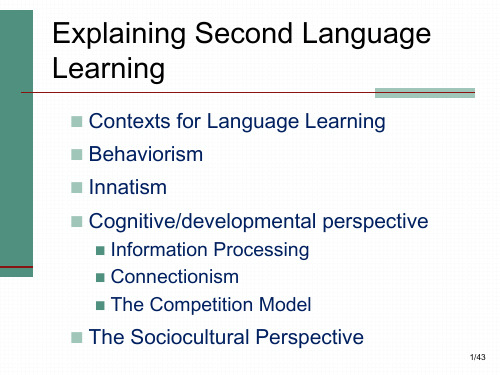
10/43
Innatism:
Universal Grammar
UG and SLA
1. Chomsky has not made specific claims about the implications of his theory for second language learning. Nhomakorabea5/43
Behaviorism
Four characteristics of behaviorism:
1) imitation, 2) practice, 3) reinforcement, and 4) habit formation
Brooks (1960) & Lado (1964): - emphasizing mimicry and memorization (audiolingual teaching methods)
2/43
Differences in Learning L1 & L2
Learner Characteristics
1. Knowledge of another language
2. Cognitive maturity 3. Metalinguistic awareness 4. World Knowledge 5. Anxiety about speaking
(grammar and pronunciation) 9. Corrective feedback: (meaning, word choice, politeness) 10. Modified input
浅谈英语专业二外日语的教学

浅谈英语专业二外日语的教学作者:蒋欢来源:《教育界》2012年第33期【摘要】根据教育部的相关规定,高等院校英语专业的学生需要选修一门第二外语。
在众多的第二外语选择中,日语仍然占据首要地位。
本文意在通过对英语专业学生二外日语学习优越性以及英语专业学生二外学习现状的分析,探讨教学中如何更好地满足学生的要求,探寻更好地培养学生的日语实际运用能力的有效方法。
【关键词】英语专业学生二外日语教学方法一、英语专业二外日语学习的优越性对于英语专业学生来说,相比较于其他第二外语,学习日语具有明显优越性。
如能充分发掘,合理加以运用,将对日语学习的提高有很大促进作用。
中日两国同属东亚文化圈、汉字文化圈,有悠久的文化交流历史。
这使中日两国人民产生了一种文化的连带感与亲近感,相对于迥异的西方文明,人们更容易看到彼此之间“同文”的共通性,而且日语是以汉语为基础发展起来的一门语言。
现代日语当中保留有两千个左右的常用汉字。
这些汉字的大多数和中文中汉字在字形和词义上基本或完全相同。
所以对于一名中国学生来说,学习日语有欧美国家学习者无法比拟的优越性。
在日语学习中,汉语或多或少起着一定的正面迁移作用。
但是,千万不能因为“汉字”的关系,而把日语当成汉语来学。
有些汉字字形虽然完全一致,但文化内涵却相差甚远。
而且除了借用汉语汉字外,日语还根据自身的历史文化,风土人情等自创了很多汉字。
这类汉字是汉语中没有的。
因此在日语学习中学习者既要发挥“汉字”的优越性,同时也要努力克服汉字先入为主的负面影响,真正发挥优势的能动性。
二、二外日语教学的现状及影响因素一般来说,二外日语从英语专业本科三年级开始设立,学习时间与专业日语一年级日语精读时间大致相当。
然而笔者在多年教学实践中发现,英语专业学生二外日语的掌握程度与专业日语一年级学生相比有相当的差距。
此外,很多英语专业学生反映,同等时间内他们的日语学习效果也远不如英语。
同样是零起点学习日语,英语专业学生和日语专业学生为何会出现如此大的差距呢?哪些因素影响了英语专业二外日语学习的效果?基于多年实践的总结,笔者欲从以下两个方面来分析。
德国 中学 第二外语 汉语

德国中学第二外语汉语
德国的中学课程中,第二外语选修科目中有汉语。
学生们可以选择学习中文作为他们的第二外语。
学生们在中学的汉语课程中,会学习汉字的基本笔画和发音。
通过学习拼音,他们可以逐渐掌握中文的发音规则。
此外,他们还会学习基本的词汇和句子结构,以便能够进行简单的对话和交流。
除了语言的学习,学生们也会了解中国的文化和历史。
他们会学习中国的传统节日,如春节和中秋节,并了解中国的饮食、服饰和艺术等方面的知识。
汉语作为一门重要的国际语言,学生们学习汉语可以为他们的未来提供更多的机会。
他们可以在旅游、商务和交流方面受益,也可以开拓更多的就业机会。
总的来说,德国的中学生们有机会选择学习汉语作为他们的第二外语。
这不仅可以提高他们的语言能力,还可以让他们更好地了解中国的文化和历史。
欧洲 第二外语主流教学方法

欧洲第二外语主流教学方法在欧洲,学习第二外语已成为教育体系的重要组成部分。
为了提高教学效果,教育者们不断探索并实践各种教学方法。
本文将为您详细介绍欧洲第二外语的主流教学方法。
一、沉浸式教学法沉浸式教学法(Immersion Method)是一种将学生完全置于目标语言环境中的教学方法。
在这种教学法中,学生不仅在语言课堂上,而且在课外活动和日常生活中,都尽量使用目标语言进行沟通。
这种方法有助于学生迅速提高语言能力,增强语感。
二、交际式教学法交际式教学法(Communicative Language T eaching,CLT)强调语言的交际功能,注重培养学生的实际运用能力。
在这种教学法中,教师会组织各种交际活动,如角色扮演、小组讨论等,让学生在真实或模拟的情境中运用语言。
这种方法有助于提高学生的听说能力,培养他们的跨文化交际能力。
三、任务型教学法任务型教学法(Task-based Language Teaching,TBLT)以任务为核心,将语言学习与完成任务相结合。
教师会设计各种真实或接近真实情境的任务,让学生在完成任务的过程中学习语言。
这种方法有助于激发学生的学习兴趣,提高他们的语言实践能力。
四、内容型教学法内容型教学法(Content-based Instruction,CBI)将语言学习与学科知识相结合。
在这种教学法中,教师会使用目标语言教授其他学科的知识,如历史、地理等。
这种方法有助于提高学生的语言水平,同时拓宽他们的知识面。
五、翻转课堂翻转课堂(Flipped Classroom)是一种将传统课堂内外教学活动颠倒的教学模式。
在这种教学模式中,学生在课前通过在线资源自主学习语言知识,课堂时间主要用于讨论、实践和解决问题。
这种方法有助于提高学生的自主学习能力和课堂参与度。
六、多媒体辅助教学多媒体辅助教学(Multimedia-assisted Language Learning)利用计算机、网络、音视频等多种媒体资源,为学生提供丰富的学习材料。
探究英语专业学生学习第二外语的必要性及策略
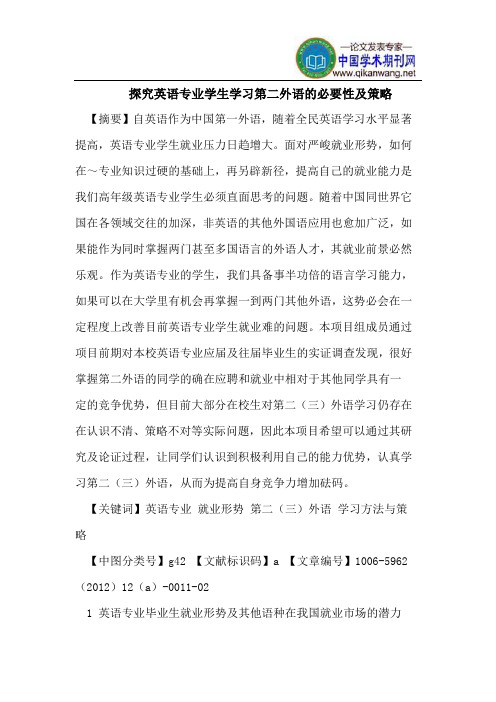
探究英语专业学生学习第二外语的必要性及策略【摘要】自英语作为中国第一外语,随着全民英语学习水平显著提高,英语专业学生就业压力日趋增大。
面对严峻就业形势,如何在~专业知识过硬的基础上,再另辟新径,提高自己的就业能力是我们高年级英语专业学生必须直面思考的问题。
随着中国同世界它国在各领域交往的加深,非英语的其他外国语应用也愈加广泛,如果能作为同时掌握两门甚至多国语言的外语人才,其就业前景必然乐观。
作为英语专业的学生,我们具备事半功倍的语言学习能力,如果可以在大学里有机会再掌握一到两门其他外语,这势必会在一定程度上改善目前英语专业学生就业难的问题。
本项目组成员通过项目前期对本校英语专业应届及往届毕业生的实证调查发现,很好掌握第二外语的同学的确在应聘和就业中相对于其他同学具有一定的竞争优势,但目前大部分在校生对第二(三)外语学习仍存在在认识不清、策略不对等实际问题,因此本项目希望可以通过其研究及论证过程,让同学们认识到积极利用自己的能力优势,认真学习第二(三)外语,从而为提高自身竞争力增加砝码。
【关键词】英语专业就业形势第二(三)外语学习方法与策略【中图分类号】g42 【文献标识码】a 【文章编号】1006-5962(2012)12(a)-0011-021 英语专业毕业生就业形势及其他语种在我国就业市场的潜力改革开放以来,英语已成为我国第一外语,历时数年,国民总体英语学习水平显著提高,这使得近年来英语专业毕业的学生的就业形势不容乐观。
在《2010年中国大学生就业报告》和《2011年中国大学生就业报告》中显示:毕业半年后失业人数最多的10个本科专业失业人数为10.38万人,占了本科失业总人数的33.3%,其中英语是2007-2011连续五届失业人数最多的8个专业之一,英语也因此成为就业红牌警告专业,这里“红牌专业”理解为失业量较大,就业率持续走低,且薪资较低的专业中综合考虑的前10个专业,为高失业风险型专业。
假期学习自我提升计划
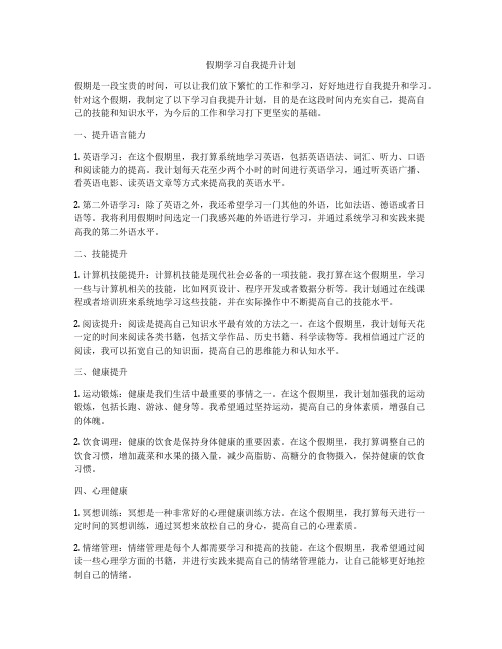
假期学习自我提升计划假期是一段宝贵的时间,可以让我们放下繁忙的工作和学习,好好地进行自我提升和学习。
针对这个假期,我制定了以下学习自我提升计划,目的是在这段时间内充实自己,提高自己的技能和知识水平,为今后的工作和学习打下更坚实的基础。
一、提升语言能力1. 英语学习:在这个假期里,我打算系统地学习英语,包括英语语法、词汇、听力、口语和阅读能力的提高。
我计划每天花至少两个小时的时间进行英语学习,通过听英语广播、看英语电影、读英语文章等方式来提高我的英语水平。
2. 第二外语学习:除了英语之外,我还希望学习一门其他的外语,比如法语、德语或者日语等。
我将利用假期时间选定一门我感兴趣的外语进行学习,并通过系统学习和实践来提高我的第二外语水平。
二、技能提升1. 计算机技能提升:计算机技能是现代社会必备的一项技能。
我打算在这个假期里,学习一些与计算机相关的技能,比如网页设计、程序开发或者数据分析等。
我计划通过在线课程或者培训班来系统地学习这些技能,并在实际操作中不断提高自己的技能水平。
2. 阅读提升:阅读是提高自己知识水平最有效的方法之一。
在这个假期里,我计划每天花一定的时间来阅读各类书籍,包括文学作品、历史书籍、科学读物等。
我相信通过广泛的阅读,我可以拓宽自己的知识面,提高自己的思维能力和认知水平。
三、健康提升1. 运动锻炼:健康是我们生活中最重要的事情之一。
在这个假期里,我计划加强我的运动锻炼,包括长跑、游泳、健身等。
我希望通过坚持运动,提高自己的身体素质,增强自己的体魄。
2. 饮食调理:健康的饮食是保持身体健康的重要因素。
在这个假期里,我打算调整自己的饮食习惯,增加蔬菜和水果的摄入量,减少高脂肪、高糖分的食物摄入,保持健康的饮食习惯。
四、心理健康1. 冥想训练:冥想是一种非常好的心理健康训练方法。
在这个假期里,我打算每天进行一定时间的冥想训练,通过冥想来放松自己的身心,提高自己的心理素质。
2. 情绪管理:情绪管理是每个人都需要学习和提高的技能。
- 1、下载文档前请自行甄别文档内容的完整性,平台不提供额外的编辑、内容补充、找答案等附加服务。
- 2、"仅部分预览"的文档,不可在线预览部分如存在完整性等问题,可反馈申请退款(可完整预览的文档不适用该条件!)。
- 3、如文档侵犯您的权益,请联系客服反馈,我们会尽快为您处理(人工客服工作时间:9:00-18:30)。
Center for Second Language Studies
Orientation Session Presentation August 21, 2012 Virginia Scott
Rethinking Grammar Teaching
INPUT PROCESSING
THE Questions
(ORAL or WRITTEN input?)
2. Matching
What do you like?
I like … books. movies. music. nature. pizza. jokes. new clothes.
(ORAL or WRITTEN?)
I like … hiking. shopping. eating. laughing. reading. dancing. watching TV.
• “ing” verbs are preceded by a helping verb:
to be (I am reading) to like (I like shopping)
Guiding principles for input processing:
Use both oral and written input. Focus on meaning before form. Have learners DO something with input. Design activities that require both discrete (one answer) and open-ended (personal opinion) answers. Have learners state the rule as final phase of the lesson.
Traditional / Input processing:
A review
1) Traditional approach: input developing system output
focused practice 2) IP approach: input developing system output focused practice
3. Selecting alternatives
When I have free time I enjoy ___ watching TV. ___ reading a book. ___ talking to friends. When I am hungry I prefer ___ going out to a restaurant. ___ cooking dinner at home. ___ getting fast food. When I go out with my friends we like ___ going to the movies. ___ sitting in a bar. ___ dancing in a club.
NOTE
For BOTH the traditional approach and the input processing approach teaching grammar includes three main phases: 1) providing input 2) fostering learners’ developing language system 3) encouraging output
Traditional approach
Traditional approach: input developing system output focused practice
a) Learners see or hear input. b) They think about it … (?) c) They practice during output.
(ORAL or WRITTEN?)
4. Supplying information
Fill in the blanks below and be prepared to share the information. Name ____________________
I like eating _______________________________. I love drinking _____________________________. I enjoy watching ___________________________. I prefer reading _____________________________. I do not like going _____________________________.
Input processing approach
IP approach: input developing system output focused practice
a) Learners see or hear input. b) They DO something with what they see or hear. c) They produce the word or structure.
I like eating pizza. I enjoy going to the movies. I do not like hiking. I hate watching TV. I really like reading books. I do not like riding a bike. I like hiking. I love dancing.
Structure: verbs with “ing” Topic: leisure activities
Going to the movies Shopping at the mall Eating pizza at Mafiosa’s Watching TV Talking to friends Riding a bike Dancing at a club Hiking at Radnor Lake Park Reading a book Sleeping late
Elicit the rule State the rule clearly
• You can add “ing” to verbs.
• You can state preferences before the “ing” verb:
I like going / I hate eating / inition & Principles
Input Processing
Input processing is an approach to grammar instruction that guides learners to process what they see or hear.
This approach helps learners connect language forms with their intended meanings. Learners must DO something with the input they see or hear.
Four kinds of IP activities:
1) Binary options 2) Matching 3) Selecting alternatives 4) Supplying information
**Reminder: Students are listening OR reading and DOING something with what they hear/see. They are NOT speaking.
1. Binary options
Indicate if you think the statements are TRUE or FALSE: TRUE _____ _____ _____ _____ _____ _____ _____ _____ FALSE _____ _____ _____ _____ _____ _____ _____ _____
References
Farley, Andrew. 2004. Structured Input: Grammar Instruction for the Acquisition-Oriented Classroom. New York: McGraw Hill. Lee, James and Bill VanPatten. 2003. Making Communicative Language Teaching Happen (2nd ed.). New York: McGraw Hill. Wong, Wynne. 2004. Input Enhancement: From Theory and Research to the Classroom. New York: McGraw Hill.
